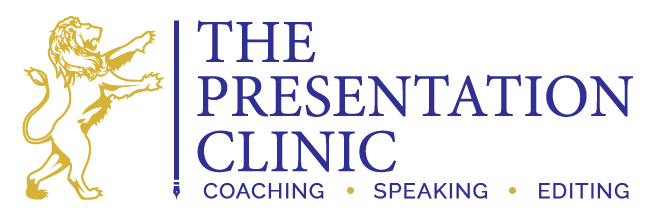10 tips for better public speaking
Wednesday Workshop Series
18th October 20165 Tips for Looking More Confident
14th August 2017Everyone wants to be a better public speaker and it’s a lot easier than you might think. The secret is in preparation and a few mind tricks that help you conquer those nerves.
Here are The Presentation Clinic’s top 10 tips for improving your public speaking…
- Prepare, prepare, prepare: Benjamin Franklin said it best – “By preparing to fail, you are failing to prepare.” The best public speakers might make it look easy, but make no mistake. They have practised their speech or presentation dozens of times. Not only does practising more help settle the nerves, it also gives you more confidence, allowing you to make more eye contact with your audience. A good speech should be practised at least a dozen times.
- Plot your script: you might take only keywords with you up to the podium, but every good speech should start with a full draft. Use that draft to mark your pauses and other dramatic elements, such as increasing or decreasing your pace or volume, so that these “scribbles in the margin” can guide you as you practise. When we write a Word document, we use things like bold, underlining or italics to add emphasis. You should do the same with your text to help you bring that script to life. Remember that the audience does not have a hard copy of your speech. They are relying on your delivery to get the message. Make it as easy as possible for them to “get it”.
- Use a mirror: you got the bit about “prepare, prepare, prepare”, right? Help yourself by standing in front of the mirror when you practise your speech. You’ll notice right away if you are using your hands too much or too little, or if your face isn’t animated enough. Get used to seeing yourself “perform” your speech.
- Feel what you say: the voice will always follow the face. Whatever expression you have on your face, your voice will support. Think about it…you know immediately on the phone how the other person is feeling. You can hear sadness, or excitement, as well as see it. Animate your face as much as possible during your speech. Again, you want to bring your script to life. The best speakers aren’t afraid to show their feelings and neither should you.
- Command the stage: Don’t cling to the podium. Take a half step back, or even to the side. If the venue allows for it, move! If not, then stand still with your feet planted into the ground, relying on your arms, your hands and your face to convey dynamism. No one wants to watch a wooden speaker. And don’t be afraid to rehearse your movements and your gestures. There’s nothing quite like rehearsed spontaneity.
- Have a goal: we encourage all our clients to have a goal. In their coaching we teach them to ask themselves: “how do I want my audience to feel at the end of my speech?”. What’s the emotion you want to leave them with? Put that front-and-centre when you brainstorm ideas for your speech. You’ll be amazed at the difference this makes.
- Free your mind: most of our clients come to us for coaching because they find the prospect of public speaking terrifying. They are not alone. “Glossophobia”, the fear of speaking in public, is the world’s most common phobia. They are more people afraid of public speaking than death! At the root of this is the fear of what the audience will think. You cannot control this, so why worry about it? Give yourself permission not to worry about how the audience will react. You just focus on being as prepared as you can. Your only job is to give the best speech you can give. Daunted? Good. That signals to you that what you are about to do is important.
- Put everything into it: public speaking requires energy. Lots of energy. Even with a relatively short five minute speech, you should feel tired after delivering it. The more energy you put it in, the more dynamic a speaker you will seem. Energise yourself before speech time. Take a few really deep breaths and visualise success. Let your voice fill the room and talk to the back of it.
- Control the nerves: it’s said that the best way to control the “butterflies” is to visualise them flying in formation. If you are really nervous, remind yourself of how prepared you are. Muster the energy to deliver a strong and clear opening line. By the time you’ve delivered that, you should already be feeling better. Deep-breathing techniques are the best way to settle the nerves. While you’re backstage, or being introduced, take a few breaths in the through the nose and out through the mouth.
- Don’t end with “thank you”: it’s the audience’s job to thank YOU after the speech. If you’ve structured your speech well, you should have a strong closing statement that is obviously the end of your speech. It’s the same trick those classical music composers used back in the 17- and 18-hundreds. End with a bang, so the audience know when it’s time to clap. Be confident. You”ve got this.
The Presentation Clinic is based in Phnom Penh, Cambodia, and offers coaching in public speaking and sales presentations. Find us on the web at www.presentationclinic.net
